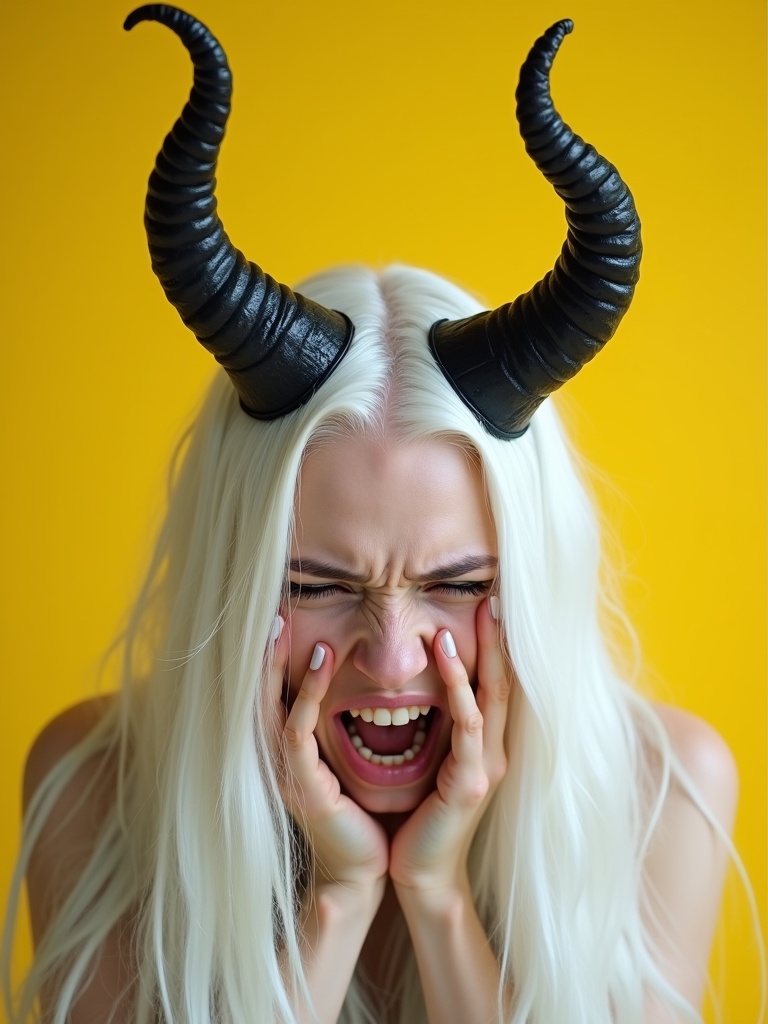A powerful and evocative photograph in the style of Annie Leibovitz, capturing a young, beautiful woman with striking white hair and delicate features, yet burdened by the demonic horns protruding from her head. Her expression is one of helpless rage—eyes tightly shut, brows furrowed, and hands gripping the base of the horns as if trying to tear them off. The yellow background amplifies the intensity of her emotions, creating a surreal and visually arresting contrast between her anguish and the vibrant hue. The image conveys a profound sense of inner conflict, as she despises the very symbol of her cursed existence."
Key Details:
The Woman (Central Figure):
Appearance:
Her face is youthful and exquisitely beautiful, with smooth, pale skin and sharp, symmetrical features.
Her long, flowing white hair cascades down her shoulders, framing her face and blending seamlessly with the ethereal quality of the scene.
Two large, curved demon horns emerge from her temples, their dark, textured surface contrasting sharply with the softness of her hair and skin.
Pose:
She sits or stands slightly hunched, her body language conveying vulnerability and frustration.
Her hands clutch the base of the horns with desperate force, veins visible on her fingers as she struggles against them.
Her eyes are squeezed shut, tears streaming down her cheeks, emphasizing her torment and rejection of the horns.
Emotion & Expression:
Facial Expression: Her clenched jaw, furrowed brows, and tear-streaked face communicate raw emotion—anger, despair, and self-loathing.
Body Language: The tension in her arms and shoulders suggests an internal battle, as though she is physically and emotionally exhausted from fighting her fate.
Background & Color Palette:
Yellow Background: A bold, solid yellow backdrop dominates the image, creating a stark and surreal contrast with her pale complexion and dark horns. The brightness of the yellow amplifies the intensity of her emotions, making her anguish feel even more visceral.
Symbolism of Yellow: The color yellow can represent both warmth and toxicity, mirroring her internal struggle—it highlights her beauty but also underscores the curse she carries.
Lighting & Atmosphere:
Lighting Style: Soft, diffused lighting illuminates her face and upper body, ensuring every detail of her expression and the texture of her horns is clearly visible. Shadows are minimal, keeping the focus entirely on her emotional state.
Mood: The atmosphere is charged with tension and melancholy, drawing viewers into her world of pain and defiance. The simplicity of the yellow background ensures there are no distractions from her story.
Photographic Style (Annie Leibovitz Influence):
Composition: The framing is intimate and deliberate, placing her at the center of the image to emphasize her isolation and vulnerability.
Focus: Sharp focus on her face and hands, capturing every tear, wrinkle, and vein, while the yellow background remains smooth and untextured.
Emotional Depth: The photograph invites empathy and introspection, encouraging viewers to connect with her suffering and question the origins of her curse.
Props & Minimalism:
Minimal Props: The absence of additional props or clutter ensures all attention is directed toward her emotional state and the symbolism of the horns.
Horns as Central Symbol: The horns are intricately detailed, with a matte black or dark metallic finish, resembling polished bone or obsidian. Their size and prominence make them impossible to ignore, symbolizing the weight of her burden.
Color Contrast:
Dominant Colors: The image juxtaposes the cold tones of her pale skin and white hair with the warm, almost overwhelming brightness of the yellow background. This contrast heightens the visual impact and reinforces the duality of her character—beauty and curse intertwined, Emotionally charged portrait of a woman with white hair and dark horns. She is screaming in frustration, eyes shut tight. Yellow background enhances her anguish. Captures inner conflict and beauty











